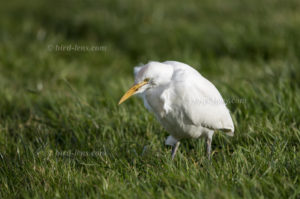 A small road and a deep ditch are one of the ingredients of a birdwatching trip in Noord-Holland. Right now, an additional add-on is the sighting of a Cattle Egret (Bubulcus ibis). This Egret is rare in middle Europe but a common inhabitant of southern Europe. If you want to save time and distance you might try to look for this nice egret in a Nature reserve at the coast of Noord Holland near Camperduin.
A small road and a deep ditch are one of the ingredients of a birdwatching trip in Noord-Holland. Right now, an additional add-on is the sighting of a Cattle Egret (Bubulcus ibis). This Egret is rare in middle Europe but a common inhabitant of southern Europe. If you want to save time and distance you might try to look for this nice egret in a Nature reserve at the coast of Noord Holland near Camperduin.
During year end this egret stayed in the Harger- en Pettemerpolder, a reserve quite recently established to protect habitats for waders, ducks and geese. Narrow and windy roads along deep ditch pass the area. The Cattle Egret could be seen the first day on a wet meadow in some distance. On the way back, the egret was gone. Lucky man, I thought and only chose the road by accident the next day. This time the egret was standing right to the side of the road allowing for the image of the blog. And also on the next day the bird was there. This time standing in the garden of a small farmhouse together with a Herring Gull (Larus argentatus). The whole time I saw the egret in search of food, but could not see on what prey it was feeding. But obviously the habitat provided for enough food to stay for several days.
In general, the whole area in Noord-Holland is excellent for bird observations. E.g. an adult Lesser Yellowlegs (Tringa flavipes) could be observed north of Callantsoog in the newly established nature reserve “The Nollen van Abbestede” in June 2013. Again, there was a notice on www.waarneming.nl, that someone reported that a Lesser Yellowlegs had been seen again in the wetland Nollen van Abbestede.
The Cattle Egret (as the Lesser Yellowlegs) is a really rare bird for Germany. But in The Netherlands this egret (as the wader) occurs on a more regular frequency.
Just behind the Hondsbossche Zeewering lies the vast Harger and Pettemer polder. From the dike you have a beautiful view of the open meadows in the polder. The pattern of plots and ditches has been there since the Middle Ages. Especially the De Putten section is known, because many birds can be seen here. In the summer there are many different flowers, the polder is one large color palette.
The De Putten area is very popular with birds – and with birders – because of the many ponds that have formed after clay extraction. Especially in the winter it is full of ducks and geese.
From the dike, the parking lot and the quiet roads and paths around the area you can watch the birds well. By car you should follow the N9 to Burgervlotbrug. Turn off towards Petten. Take the second exit on the left onto Hondsbosscheweg. After approximately 2 km there is a parking lot on the right.
In order to meet the growing demand for top images of the rarer species of Palearctic Bird-lens.com has specifically made trips to remote places like the coastal mountains of western Norway, in the winter to a secluded harbor in Denmark, or – right now – to the dunes of The Netherlands. This to do everything to ensure excellent photos of the Birds of the Western Palearctic. The yield of pictures also of rare Western Palearctic birds is very good. The beautiful picture that you see in blog is just a first impression of what you will find behind the tab “Picture- Shop” very soon. Just give a notice if you need a picture of a bird before the new images are online.